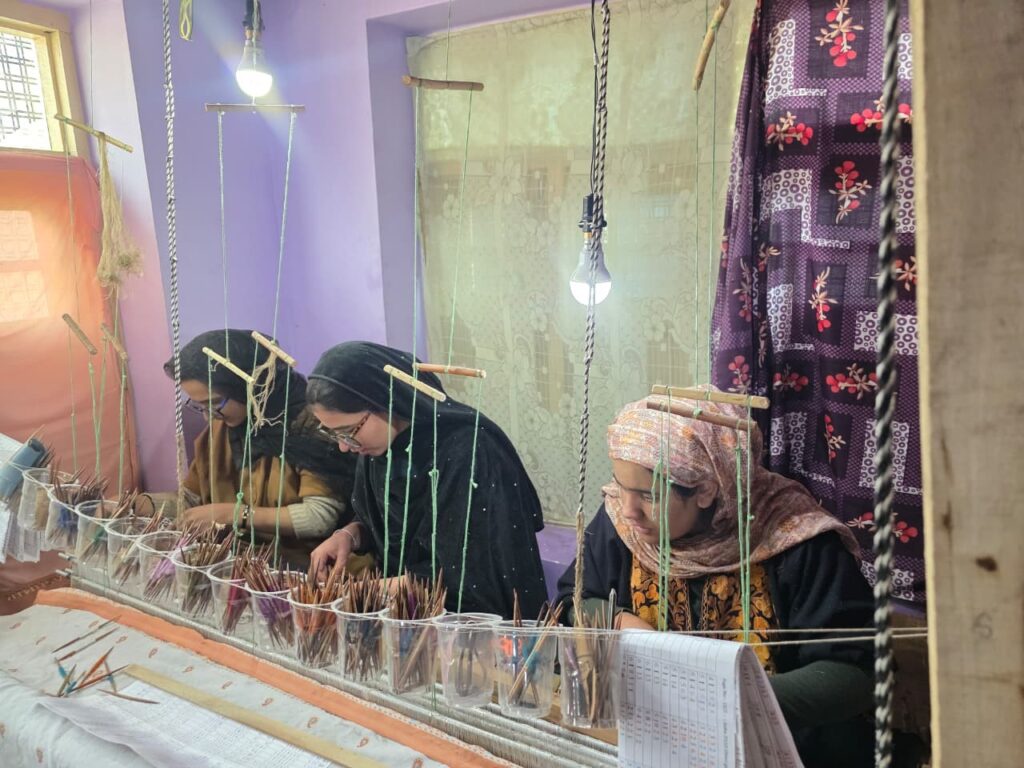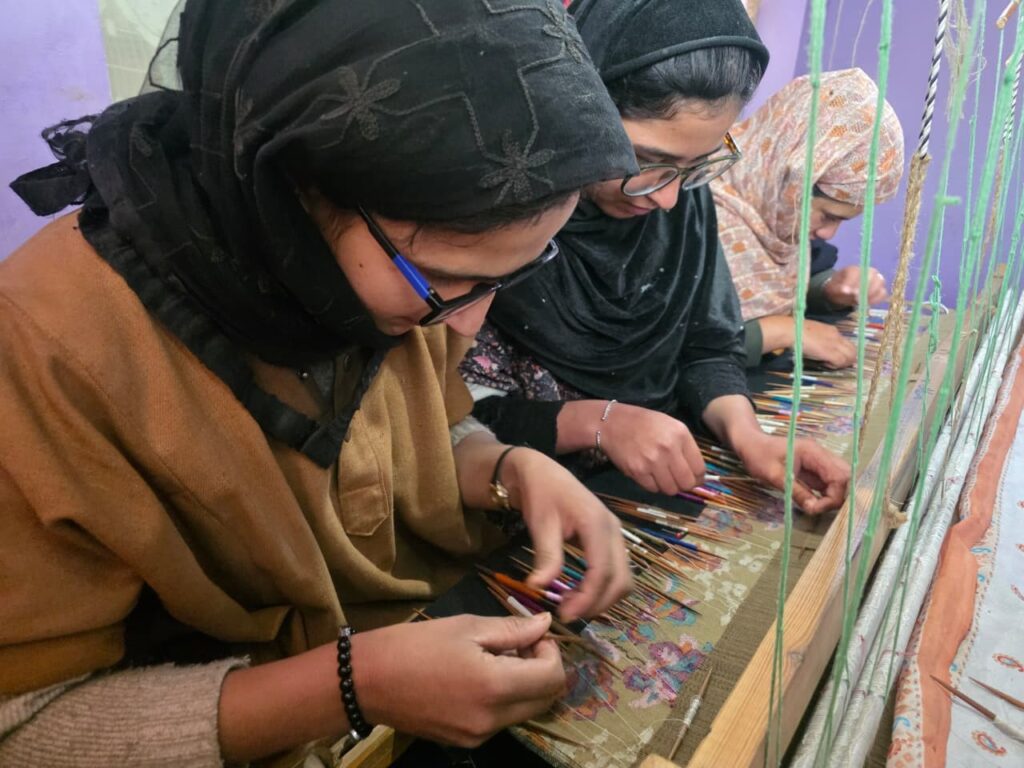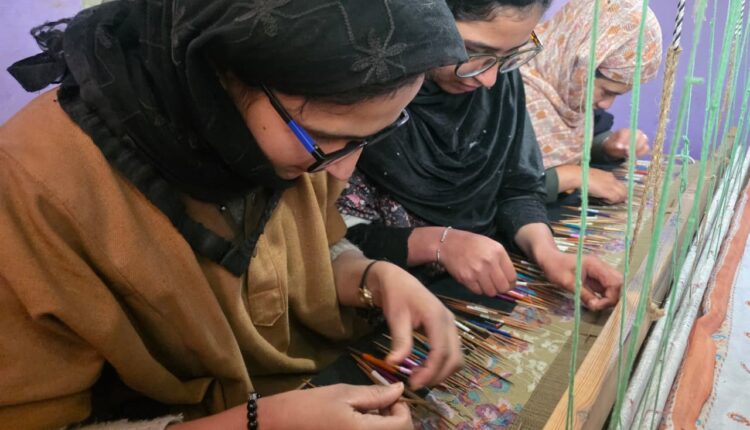Threads of Empowerment
In Wasimarg, women artisans are turning centuries-old Pashmina craft into a source of empowerment and pride.
By Arsheed Ahmad Bhat
In the serene foothills of Yousmarg, about 30 kilometers from Pulwama, a quiet revolution is taking shape. The village of Wasimarg, tucked away in the heart of rural Kashmir, is home to a group of ten determined women artisans who have turned age-old craft into a source of empowerment and economic independence. Under the aegis of the Jammu & Kashmir Rural Livelihoods Mission (JKRLM), the Zanib Self Help Group (SHG) has become a beacon of how tradition, when paired with opportunity, can transform lives.
For generations, the intricate art of Pashmina weaving and Sozni embroidery has been a symbol of Kashmir’s cultural soul — delicate, time-consuming, and immensely valued across the world. Yet, for many rural women, these skills remained confined within their homes, rarely translating into economic freedom. The Zanib SHG is rewriting that story.

Comprising ten women artisans, each armed with the skill passed down through fathers, brothers, and elders, the group embodies both heritage and hope. Their journey began modestly but has now blossomed into a thriving enterprise that produces exquisite Pashmina shawls, reflecting the very essence of Kashmiri craftsmanship.
With initial financial assistance from JKRLM — a Revolving Fund (RF) of ₹15,000 and a Community Investment Fund (CIF) of ₹65,000 — the group was able to strengthen its business base. This support not only helped them procure raw materials and tools but also gave them the confidence to scale up production. Their most recent creation, a batch of fine Pashmina shawls worth ₹1.85 lakh, stands as a testament to their growing skill and business acumen.
For the women of Wasimarg, this success means more than just financial gain. It marks a journey from dependency to dignity, from isolation to inclusion.
“This work requires immense patience, dedication, and love for art,” said Muskaan Shafi, one of the active members of the group, her hands deftly tracing the delicate threads of an unfinished shawl. “We have been engaged in Pashmina and Sozni work for the last three years. I personally learned this craft from my brother. It is completely different from other handicrafts, and through JKRLM we got the opportunity to turn our skill into a sustainable income source.”
Her words reflect the resilience of countless Kashmiri women who are redefining the contours of empowerment through self-help groups. For them, every thread spun and every stitch woven is not just a piece of art — it’s a statement of self-reliance.
Muskaan recalls how it all began. “Three years ago, a team from JKRLM Pulwama visited our village for mobilisation. We joined the SHG movement, and since then, we have received continuous support from access to credit and training to linkages with the Handicrafts Department. Today, we proudly contribute to preserving this traditional art while earning a dignified livelihood.”
Her story mirrors that of many others in rural Kashmir who have found a new identity through collective effort. The SHG model — a cornerstone of JKRLM’s rural empowerment strategy — provides women with financial literacy, entrepreneurial training, and direct access to government schemes. But beyond institutional support, it has fostered something even more valuable: solidarity and confidence among women who once saw themselves as mere caretakers of their homes.
Arsheed Ahmad Bhat, District Programme Manager (Livelihoods), JKRLM Pulwama, believes Zanib SHG’s story encapsulates the mission’s true spirit. “Zanib SHG from Wasimarg is a true example of how women, when given the right platform and support, can transform traditional skills into sustainable livelihoods. JKRLM aims to reach even the remotest corners of Pulwama to empower women economically and socially. Our mission is to ensure that every talented woman artisan receives the recognition, financial assistance, and market exposure she deserves. The success of this group will certainly motivate many others to join the SHG movement.”
His words carry weight, for the transformation unfolding in Wasimarg is not an isolated one. Across Jammu and Kashmir, hundreds of SHGs are turning traditional arts — once on the brink of extinction — into thriving rural industries. From papier-mâché to crewel embroidery, women are reclaiming crafts that had long been overshadowed by machine-made imports and market neglect.

For Wasimarg’s artisans, the journey has also been personal. The freedom to earn and contribute economically has altered family dynamics and community perceptions. Husbands who once viewed handicraft work as secondary now take pride in their wives’ success. Daughters see in their mothers not just homemakers but entrepreneurs.
JKRLM’s continuous engagement — through workshops, exposure visits, and skill enhancement programs — has ensured that groups like Zanib SHG remain competitive in a changing market. By linking them with the Handicrafts Department, the mission has opened channels for marketing, branding, and fair pricing — areas where rural artisans often struggled.
The ripple effect is visible. Where once young girls hesitated to pursue traditional crafts, now they see a future in them. What was once an informal household activity is now an organized livelihood model. The women of Zanib SHG not only preserve an ancient art form but also embody the evolution of Kashmiri rural women into artisans, business owners, and change-makers.
Beyond their artistry, the group’s collective spirit is its strongest thread. They meet regularly to discuss finances, plan production schedules, and share new designs. Each member contributes not only to the craft but also to the group’s decision-making, reinforcing the values of equality and collaboration that define the SHG movement.
For Wasimarg — a remote village often cut off during harsh winters — the success of this group offers a glimpse of a brighter, self-sustaining future. It’s a model of development rooted in local talent, community participation, and cultural pride.
The broader vision of JKRLM — known locally as Umeed — is to empower rural women by providing them with financial tools and institutional support to enhance their income-generating capacity. It aims to make women active participants in the region’s development narrative rather than passive beneficiaries.
The Zanib SHG’s journey perfectly encapsulates this vision — one where empowerment is woven through the threads of culture, perseverance, and self-reliance.
As the women of Wasimarg sit together in their small workspace, surrounded by skeins of fine Pashmina and the rhythmic click of needles, they represent more than artisans at work. They represent a movement — one that blends tradition with transformation, craftsmanship with confidence, and art with aspiration.
Through their hands, the delicate threads of Pashmina become more than just fabric; they become a tapestry of empowerment — a story of women who chose to weave their destiny, one stitch at a time.

